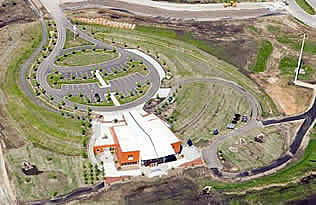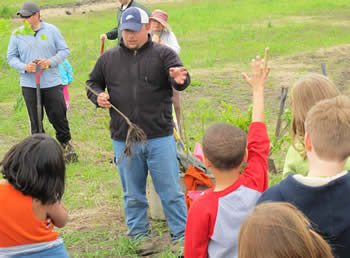Cascade Meadow / What We Do
Sustainable SiteSustainable Site
 At Cascade Meadow, we’re pretty proud of our site. We think our building and the 100 acres it sits on have a lot to offer southeast Minnesota as an educational resource.
At Cascade Meadow, we’re pretty proud of our site. We think our building and the 100 acres it sits on have a lot to offer southeast Minnesota as an educational resource.
The links on the left will take you to pages about the Building, the Landscapes, and the Natural Areas. Read them and then come and explore Cascade Meadow yourself!
The Building
 Our 16,000 square foot Environmental Science Center was designed, constructed, and operates as a high performance green building. It incorporates energy-efficient construction, passive solar design, indoor environmental quality, and renewable energy.
Our 16,000 square foot Environmental Science Center was designed, constructed, and operates as a high performance green building. It incorporates energy-efficient construction, passive solar design, indoor environmental quality, and renewable energy.
To learn about our building, click on the three links below:
- The systems within the building (including the live data on our renewable energy systems!)
- The materials chosen for the building
- The design of the building
The Landscapes
The Landscapes
 The best landscapes work with the buildings they surround , so the area surrounding any building has to be planned as carefully as the building itself. Designing a building and the areas around it so that the local landscapes of geology, hydrology, ecology, and culture work together is a kind of integrated design. When we design landscapes around a building,we must consider both how we shape the landscape and how we cover the landscape. How we answer these concerns will take into consideration how the area will be used (by people, vehicles, animals) and how it fits into the broader landscape of the site.
The best landscapes work with the buildings they surround , so the area surrounding any building has to be planned as carefully as the building itself. Designing a building and the areas around it so that the local landscapes of geology, hydrology, ecology, and culture work together is a kind of integrated design. When we design landscapes around a building,we must consider both how we shape the landscape and how we cover the landscape. How we answer these concerns will take into consideration how the area will be used (by people, vehicles, animals) and how it fits into the broader landscape of the site.
How is the landscape around the science center an example of integrated design? For the Cascade Meadow team, there were a lot of issues to consider, such as keeping water away from the building, choosing trees, shrubs and grasses, and planning pathways, sidewalks, and areas for vehicle flow and parking. Many of these issues are universal for anyone with a building site.
The designed areas immediately surrounding the building incorporate best practices for had storm water management to reduce flow rates and water pollution including:
When practicing integrated design, however, making a plant selection isn’t just about the color or location. Trees or shrubs can reduce the building’s energy use by blocking the hot sun in summer or slowing cold winds in winter. Other plants can slow storm water run-off and help the water be absorbed more quickly into the ground. In addition, by choosing native plants that are adapted to the local environment, maintenance costs can be reduced at the same time that we benefit local wildlife. Visit the Minnesota Department of Natural Resources site to learn more about the benefits of landscaping with native plants.
Similarly, shaping the landscape can have drastic impacts on the site. The slight rise of a hill or swale can provide a micro-climate for a native shrub at the same time that it guides storm water away from the building and into storm water infiltration basins. To see a complete list of the storm water features at Cascade Meadow, click here.
*Coming Soon* See a diagram highlighting some of the integrated design features of the landscapes surrounding the science center.
The Natural Areas
The Natural Areas
Wetland specialists have been in a three-year process to restore Cascade Meadow’s ninety acres of wetlands and prairie. The landscape includes seven of the eight Minnesota wetland types, a ten acre lake, three upland communities, and a habitat for Monarch butterflies. Much work has been done, including a controlled burn to cleared out invasive Reed Canary grass and soil preparation for seeding with native wetland and prairie plants.
The extensive trail system that will allow visitors to explore all of this up close! Head over to our wetlands page to learn more, and plan to visit this summer!
LOCATION
There’s a lot to see in our building, so drop by or contact us by phone or e-mail.
2900 19th Street NW
Rochester, MN 55901
507-457-8699
rochester@smumn.edu





